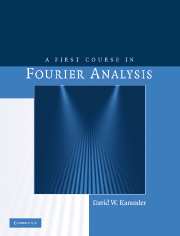Book contents
- Frontmatter
- Contents
- Preface
- 1 Fourier's representation for functions on, Tp, and ℙN
- 2 Convolution of functions on, Tp, and ℙN
- 3 The calculus for finding Fourier transforms of functions on ℝ
- 4 The calculus for finding Fourier transforms of functions on Tp, and ℙN
- 5 Operator identities associated with Fourier analysis
- 6 The fast Fourier transform
- 7 Generalized functions on ℝ
- 8 Sampling
- 9 Partial differential equations
- 10 Wavelets
- 11 Musical tones
- 12 Probability
- Appendices
- Index
7 - Generalized functions on ℝ
Published online by Cambridge University Press: 01 September 2010
- Frontmatter
- Contents
- Preface
- 1 Fourier's representation for functions on, Tp, and ℙN
- 2 Convolution of functions on, Tp, and ℙN
- 3 The calculus for finding Fourier transforms of functions on ℝ
- 4 The calculus for finding Fourier transforms of functions on Tp, and ℙN
- 5 Operator identities associated with Fourier analysis
- 6 The fast Fourier transform
- 7 Generalized functions on ℝ
- 8 Sampling
- 9 Partial differential equations
- 10 Wavelets
- 11 Musical tones
- 12 Probability
- Appendices
- Index
Summary
The concept of a generalized function
Introduction
Let y(t) be the displacement at time t of a mass m that is attached to a spring having the force constant k as shown in Fig. 7.1. We assume that the mass is at rest in its equilibrium position [i.e., y(t) = 0] for all t ≤ 0. At time t = 0 we begin to subject the mass to an impulsive driving force
When the duration ∈ < 0 is “small,” this force simulates the tap of a hammer that transfers the momentum
to the mass and “rapidly” changes its velocity from y′(0) = 0 to y′(∈) ≈ p/m.
You should have no trouble verifying that
is a twice continuously differentiable function that satisfies the forced differential equation
my″(t) + ky(t) = f∈(t)
for the motion (except at the points t = 0, t = ∈ where y″∈ is not defined), see Ex. 7.1. Here
so that sin(ωt), cos(ωt) are solutions of the unforced differential equation
my″(t) + ky(t) = 0.
Now as ∈ → 0+, the response function (2) has the pointwise limit
and it is natural to think of y0 as the response of the system to an impulse
of strength
that acts only at time t = 0 as illustrated in Fig. 7.2. The physical intuition is certainly valid, and such arguments have been used by physicists and engineers (e.g., Euler, Fourier, Maxwell, Heaviside, Dirac) for more than two centuries. And for most of …
Information
- Type
- Chapter
- Information
- A First Course in Fourier Analysis , pp. 367 - 482Publisher: Cambridge University PressPrint publication year: 2008
